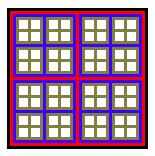11/10 - 11/12 @ Montréal, Canada
12/5 - 12/7 @ Shanghai, China
12/24 - 12/27
2/28 - 3/4 @ San Francisco, CA
More events...
2406 articles in the reference section.
Help us fight cancer!
Join SETI Team GDNet!

|
QuadtreesQuadtrees have been a favored data representation technique for many years. Particularly terrain rendering engines make use of its efficient view culling mechanism. The remainder of this section will give a short account of quadtrees and a conventional, high-level approach to using quadtrees, before describing a fast approximation. Quadtree data-structureQuadtrees are characterized by possessing four child nodes for every parent node. In a terrain rendering context the root node would represent the square region that encloses the terrain data set. The children would represent the top-left, top-right, bottom-left and bottom-right quadrants that the root node is made up of, and each of these is recursively refined with sets of four children per child upto a desired resolution. The following illustration should clarify the concept: 
A data structure for a quadtree is not difficult to program, the following pascalesque code demonstrates a typical quadtree node: TPosition = record x,y : float; end; PQuad = pointer to TQuadNode; TQuad = record p1,p2,p3,p4 : TPosition; // corners c1,c2,c3,c4 : PQuadNode; // children end; A simple recursion to initialize a quadtree to depth max_depth can be given by: function InitQuad(x,y,w : float; lev : int) : PQuad; var tmp : PQuad; begin inc(lev); if lev > max_depth then return(nil); new(tmp); ...initialize tmp node with corner data w := w / 2; tmp^.c1 := InitQuad(x - w, y - w, w, lev); tmp^.c2 := InitQuad(x - w, y + w, w, lev); tmp^.c3 := InitQuad(x + w, y + w, w, lev); tmp^.c4 := InitQuad(x + w, y - w, w, lev); return(tmp); end; Quadtree-based view cullingIn many applications the primary function of a quadtree is to offer efficient culling of data against the viewing frustrum. The following high-level description to quadtree-based view culling should suffice: Clip_Quad_against_View is the critical function within CullQuad The conventional - and certainly robust and functional - manner of resolving the question whether a quad (or any polygon) intersects the viewing frustrum, is by interpreting the view frustrum pyramid as a set of planes and interpreting a polygon as a set of rays, and then consecutively test how the polygon rays intersect the viewing planes. The equations for such a ray-plane test can be found in any good book on 3D geometry and will not be repeated here. Alternative quadtree-based view culingThe method described above yields correct results in the general case, however it does not make any provision for the simple, static structure of the quadtree. Several optimizations can be applied to the quadtree culling process. The following two-phase alternative produces a very fast and efficient quadtree-based view culling:
The following pseudo code should clarify the algorithm, for a quadtree that spans the area (0,0) to (256,256): The above functions should be clear and need only be integrated into the CullQuad procedure given earlier: |